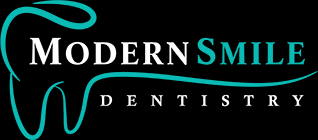Wisdom Teeth Extractions
Wisdom teeth extractions are recommended when a radiograph or x-ray shows the situation, if left untreated, will become problematic. Here at Modern Smile Dentistry we ensure if you do need to undergo a procedure to extract your wisdom teeth that it is quick and painless. If you would like to be evaluated to have your wisdom teeth extracted, please give us a call today.
“We give you a reason to smile!”
When are Wisdom Teeth Extractions Necessary?
Wisdom teeth are a normal part of the human anatomy. However, while some can erupt normally with proper spacing and angulation, there are cases where the wisdom teeth can not only be problematic, but also jeopardize the health and longevity of the neighboring teeth. Some reasons that this can happen is the incomplete eruption of the teeth. This can lead to an inflammation of the gums (pericoronitis), which can lead to an infection and discomfort. Another issue can be when the angulation of the wisdom tooth is horizontal (sideways), pushing and/or damaging the neighboring tooth, further leading to possibly the loss of both teeth. These impacted teeth, if untreated, can lead to such complexities as tumors and cysts.
What are Wisdom Teeth?
Wisdom teeth, often referred to as third molars, are the terminal (last) teeth we have in our mouths and are usually erupted (exposed) around the ages of 17-25. While the eruption of wisdom teeth are a normal process of development and growth, there are times where they can be problematic. There have been reported cases where a person can be born missing one or all their wisdom teeth, and on the opposite side of the spectrum can be born with extra ones. A panoramic radiograph will be needed to evaluate the quantity and location of wisdom teeth.

Most Common Impactions
As described aboved, there are times when wisdom teeth may be impacting neighboring teeth and lead to further issues, and deeming wisdom teeth extrations necessary. The three most common impactions are a complete bony impaction, a partial bony impaction, or a soft tissue impactions. We discuss these in more detail below.

Complete Bony Impaction
In this case, the wisdom tooth/teeth is completely engulfed and surrounded by the jaw bone. In this scenario, the tooth will need to be accessed and removed to allow for proper healing and prevent future complications to the surrounding area. This is the most complex form of impaction leading to wisdom teeth extractions.

Partial Bony Impaction
In this case, the wisdom tooth/teeth are partially impacted by the bone. Meaning that a portion of the tooth has erupted, however, another portion of the tooth is surrounded by bone. In these cases, the tooth can be leaning at varying angulations and may potentially be causing harm to the neighboring tooth. Moreover, The wisdom tooth may also be partially exposed in a way that the tooth is not able to be cleaned successfully, which can lead to decay and or infection if untreated.

Soft Tissue Impaction
In this case, the wisdom tooth/teeth are impacted by the surrounded soft tissue (gums). The crown region of the tooth has erupted past the bone, and is not retained by the gums. Here the gums can partially be partially open exposing some of the tooth or completely covering the tooth. Due to the hardship of keeping the tooth clean, this site can become inflamed (pericoronitis) causing discomfort and infection if untreated.
Do all Wisdom Teeth Need to be Removed?
It is important to remember that not all wisdom teeth require removal. With proper eruption angulation, space and oral hygiene, wisdom teeth can remain for many years as a functioning tooth. With that said, the most common scenarios that require wisdom teeth to be removed are impaction, which we described above, infection, and Inflammation.

Impaction
While some teeth erupt in the proper angulation, impaction occurs from time to time. In this case, the tooth is not angulated to properly erupt, or is unable to erupt due to other factors. This can also be the case when there isn’t enough room in the jaw for the wisdom teeth. This is important being that the third molar can damage the neighboring tooth (second molar), which can lead to the loss of both teeth.

Infection
In the case where an infection has developed in or around the wisdom tooth region, it is imperative to remove the tooth as soon as possible. Bacteria and food can get stuck and accumulate in that region causing an infection. Moreover, decay can also lead to the infection. The infection can lead to pain and other complication such as bone loss, paresthesia (loss of sensation) due to the location of an important nerve in close proximity to the wisdom tooth/teeth, amongst other complications.

Inflammation
In the case where the site(s) become inflamed, this could be a sign that there is an underlying issued or problem developing. It will be important to contact your dentist to make an appointment for an exam and evaluation. One of the most common forms of inflammation experienced in the lower third molar region is termed, pericoronitis.
Procedural Steps to Extractions
The process of receiving a tooth extraction is important to its success. Radiographs will be needed in order to ensure the extraction is necessary as well as identify any potential complications when receiving the etraction. A form of sedation is necessary and will depend on the patients preference as well as the extent of the extraction. After the tooth is removed there may be some discomfort, however, we are experts in patient comfort and will ensure your discomfort is as limited as possible.

Radiographs
The initial step will need to be the acquisition of the appropriate radiographs (x-rays) to evaluate the wisdom teeth. These radiographs will illustrate the type of impaction and if infection is present. In the case of a severe infection, a course of antibiotics may be warranted before treatment. Your dentist will inform you after the evaluation.

Anesthetics
Wisdom teeth extractions are a common dental procedure that is considered an outpatient type of procedure. This procedure can be performed in one of three ways when it comes to anesthetics;
Local Anesthetic
Here the patient in awake and aware of their surroundings. They are completely numb in the regions of extraction and will not feel pain, however, pressure can be experienced. The patient will be aware of sounds, sensations, and scenery. The patient will be able to understand and perform commands.
Conscious Sedation
Here the patient is awake but their state of mind is altered by the medication administered by their dentist. They are numb in the regions of the extractions and will not feel pain, but they may feel pressure. Being that their state of mind is altered by medication, this allows them to be more comfortable and “careless” during the procedure. This method will require another person to be present to bring them to their appointment and drive them home. A parent or legal guardian is preferred in general and required if the patient is under 18.
Intravenous (IV) Sedation
Here the patient is sedated to the point of slumber (sleeping). The step is achieved by administering medication via an IV to achieve this state of slumber. They will not have recollection of the procedure and will be awaken once the treatment has been completed. This method will require another person to be present to bring them to their appointment and drive them home. A parent or legal guardian is preferred in general and required if the patient is under 18.
*** Note: Conscious and IV sedation may not be suitable for all patients. Dr. Nima Mashhoon will inform you during your consultation step as to which method is preferred based on many factors.

Exposing the Tooth
Once the patient has been proficiently numbed by Dr. Nima Mashhoon, in the regions of the extraction, depending on the different impactions discussed above will take the proper steps to expose the tooth for a gentle extraction. The common method will be a small incision to expose the tooth. If the tooth were to be partially or fully impacted, modification of the excess bone will be warranted to remove the wisdom tooth successfully. In the incidence the case is complex, the tooth may need to be sectioned to be removed successfully.

Removing the Tooth
During wisdom tooth/teeth removal, a flap (reflection of the gums) may be necessary for the removal of the tooth/teeth. Moreover, trough (remodeling of bone) around the tooth may be justified to remove the tooth successfully. While these methods may need to be performed, they will only be performed when necessary. The tooth will then be securely removed and the site will be cleaned both mechanically and also with a solution to remove decontamination from the region. The site will then be sutured closed if deemed necessary or allow to self-heal. Cotton roll/gauze will be placed in the site to promote healing and hemostasis (stopping of bleeding). OTC (Over The Counter) pain medication will be recommended unless others are warranted. We will discuss post-operative medications with the patient and/or parent/legal guardian after the procedure.

Post-Op
While we strive to make each and every procedure as comfortable as possible, post-operative discomfort is expected after any tooth removal. Discomfort will vary from patient to patient and case by case. Medication will aid, as well as proper post-operative care that will be given to you after the procedure. Following post-operative instructions will enhance healing.

